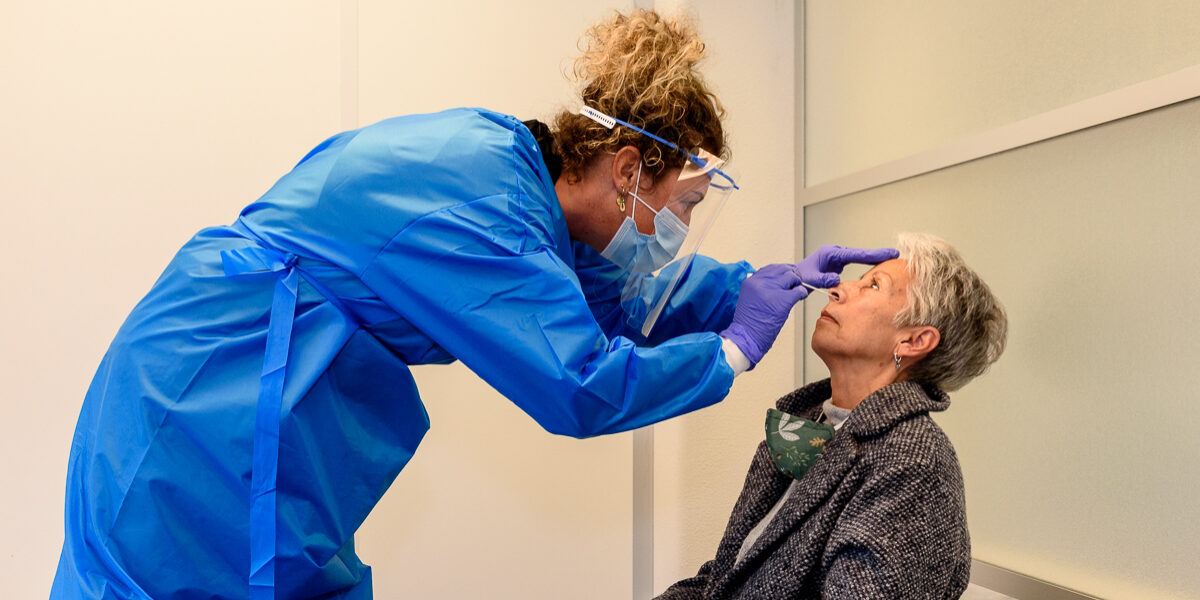Coronate test in Leiden (Photo: Rob van Dullemen)
The national number of new infections finally fell on Saturday and Sunday, but the 69,000 cases on a weekly basis were again a record. The pressure on hospitals and nursing homes is mounting. So yesterday the cabinet spoke again about stricter measures against the corona virus.
Are new measures necessary or not? The tension surrounding that question has been increasing for ten days. Prime Minister Rutte and Minister Hugo de Jonge, as national protagonists, held their cards to the chest. First look for a few days to see how ‘the figures’ develop was always the motto.
Whimsical compass
Those numbers were as erratic as a runaway compass. From mid-October, the daily number of infections remained the same for almost a week, then jumped from 8,100 to 10,000 in three days. Then a dip and a new record, a leveling off and last Friday another record of 11,141 new cases. Just try to determine your course on that.
And then this weekend came an unexpected sharp drop in the number of new infections. Yesterday there were only 8,740, more than a quarter lower than Friday. But after the fierce ups and downs of the last ten days, no one dares to count themselves rich with this. The RIVM warned that a decrease has been seen more often during the weekend.
Epidemiologists have seen bright spots in recent days. For example, they look at the national seven-day average of the infections. Yesterday it turned out that this had fallen for the first time in two months. And in our region it has been falling for several days, just like in ‘fire’ Amsterdam. In the capital, the decline is quite spectacular: last week there were almost 3,700 new cases, 1,200 fewer than the previous week.
No applause
Yet nobody dares to breathe a sigh of relief. The ‘hammer’ with which Mark Rutte wanted to sell corona a ‘big blow’ from October 14, has slowed the advance of the virus, but nothing more. August also saw a similar period of declining figures, after which the second wave really took off. Because the flu season is yet to come, the chance of a new increase in infections remains high.
And that while the pressure on healthcare is already enormous. Hospital admissions this week went from 1,630 to 1985. On Sunday, nearly 2,500 beds were occupied, 583 of which were in intensive care. The latter is an increase of twenty percent. Distressing reports are also coming from nursing homes, although those homes are no longer closed for visitors.
The difference with the spring is that the second corona wave threatens to last much longer, while the staff has not yet recovered from the first. The absenteeism rate is above ten percent, and it also turns out to be much more difficult to find additional staff. This is partly because the atmosphere is now grimmer. People no longer applaud, but react furiously to long waiting times or transfers to other hospitals. Or they take action against the masks and test streets, because the virus is said to be fake.
Crackling
The cabinet and the OMT have struggled a lot this weekend. Support in the country for new measures is faltering, but doing nothing extra may turn out to be totally irresponsible in retrospect.
Anyone who does not slow down the infections enough now will prolong the almost untenable situation in hospitals, and will soon see this reflected in high numbers of deaths. Because they are at least three weeks behind. For example, the official death rate from the virus already went to 389 this week, almost a hundred more than last week. And because the virus is now also reaching more elderly people, that figure will certainly rise further.
And so the Telegraaf reported this morning that, despite this weekend’s decline, the cabinet is considering additional measures against the spread of the virus. This would involve the closure of museums, theaters, cinemas and libraries. And about a ban on meetings with more than two people. Some of the cabinet believes these interventions are desperately needed, while others fear too great damage to the economy. It must have been a ‘crackling discussion’, the newspaper reports. Tomorrow evening it will become clear whether action is actually taken.
Leiden region
In Leiden and the surrounding area, the infections decreased somewhat more sharply last week than elsewhere. Nine percent went off in the city, six percent in the Leiden region and five percent in the entire GGD region of Hollands Midden. Hospital admissions remained practically the same, but the number of deaths showed a significant growth.
In the large GGD region, 24 deaths from corona were counted this week, almost double the previous week. Gouda had no fewer than eleven corona patients who died, Katwijk and Alphen both had four. In comparison, the damage in the Leiden region was not too bad. Leiden had two deaths and Leiderdorp one.
–
Leiden Leiderdorp Society Oegstgeest Region Advances Zoeterwoude
– .


